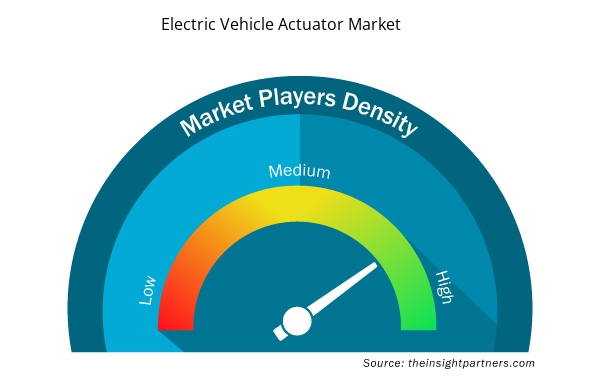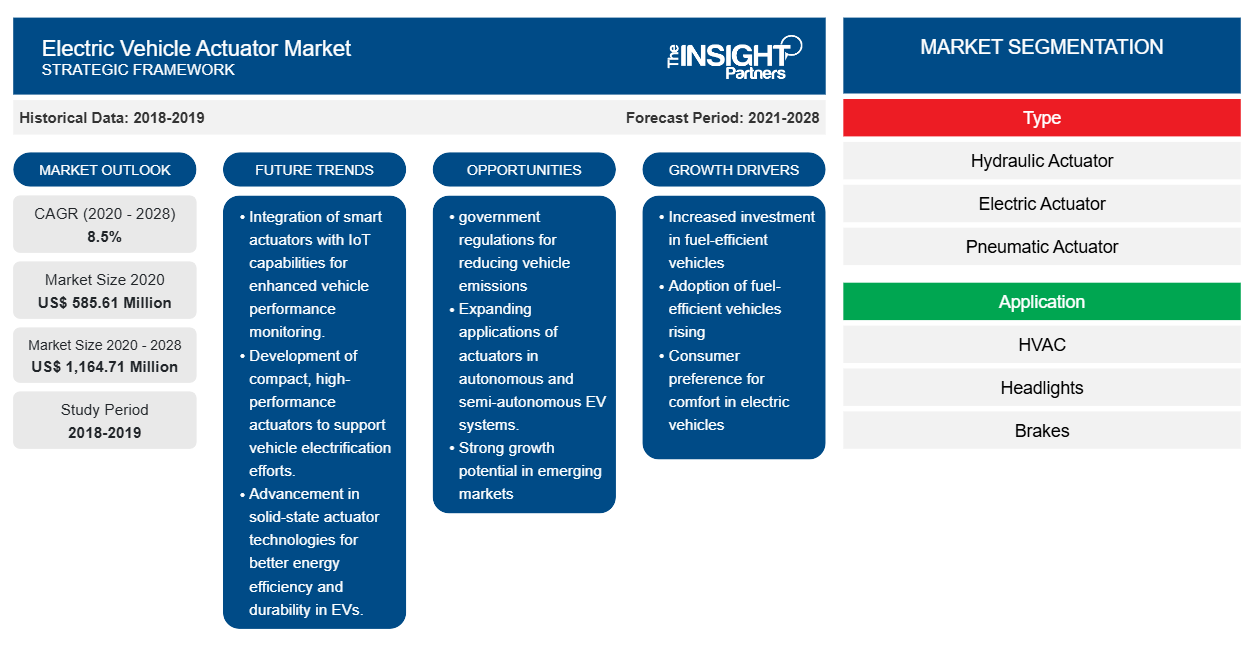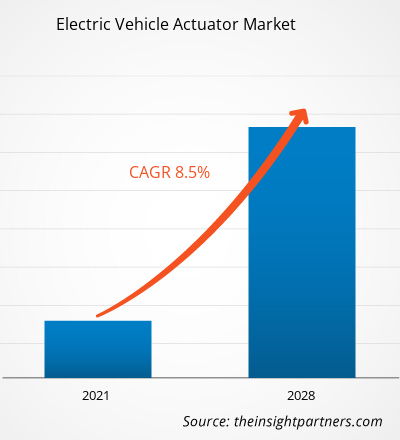2020 年电动汽车执行器市场价值为 5.8561 亿美元,预计将达到到 2028 年将达到 11.6471 亿;预计 2021 年至 2028 年的复合年增长率为 8.5%。
执行器是负责控制机构的设备的组件。执行器用于摇臂和小齿轮装置、滚珠丝杠、电机、气缸和其他组件。电动执行器正越来越多地取代液压和气动执行器,因为它们更高效、更易于控制。电动汽车执行器市场由于投资增加而增长,尤其是在欧洲地区。此外,政府对减少汽车排放的监管力度加大,增加了对节油汽车的需求,这将为市场提供增长机会。随着汽车行业的自动化和数字化,对具有先进功能和连接性的电动汽车的需求也在增长。然而,电动汽车的高资本成本或部件故障风险可能会在预测期内(2021 年至 2028 年)阻碍电动汽车执行器市场的增长。随着工业 4.0 和物联网 (IoT) 的出现,这些技术正逐渐成为整个汽车行业的主流。电动汽车 (EV) 的不断普及推动了物联网的采用和集成。然而,协作和联网汽车应用的数据集成问题给汽车电动执行器市场中的公司带来了挑战。此外,汽车电动执行器市场竞争激烈,领先企业占据了相当大的市场份额。这些市场参与者进一步支持物联网在电动汽车中的集成。因此,物联网集成在内部网络和车内连接中变得越来越突出,可以在执行器、电子控制单元 (ECU) 和传感器之间精确共享数据。因此,发展中国家缺乏电动汽车数据源和充电站网络,这对市场的增长构成了障碍。
2020 年,亚太地区在电动汽车执行器市场占据主导地位,亚太地区人口广泛采用高档汽车、轿车和 SUV 等因素显著增加了该地区的主要市场份额。此外,通用汽车霍顿、丰田汽车公司澳大利亚有限公司、福特汽车公司澳大利亚有限公司、三菱汽车澳大利亚有限公司 (MMAL)、五十铃澳大利亚有限公司、现代商用车澳大利亚有限公司和大众汽车集团澳大利亚有限公司也是该国知名的商用车制造商。所有这些制造商都要求在汽车中集成电动汽车执行器,以满足客户的新兴需求。此外,汽车制造业务的不断升级、对电动汽车的需求不断增长以及电动汽车执行器制造商越来越注重提供低成本和高效率的产品,预计将在预测期内推动亚太地区其他国家的电动汽车执行器市场的发展。
定制此报告以满足您的需求
您可以免费定制任何报告,包括本报告的部分内容、国家级分析、Excel 数据包,以及为初创企业和大学提供优惠和折扣
- 获取此报告的关键市场趋势。这个免费样品将包括数据分析,从市场趋势到估计和预测。
COVID-19 疫情对电动汽车执行器市场的影响
COVID-19 疫情严重扰乱了电子设备的供应链和制造,包括电动汽车执行器的硬件组件。COVID-19 病毒在全球的出现,随后出现封锁措施,导致行业专家分析该行业将面临电子设备供应链至少四分之一的滞后。预计这种中断将持续到 2021 年中期。在全球各国政府逐步取消各种遏制措施以重振经济后,电子设备和汽车行业可能会很快加快步伐。电子设备和汽车的生产预计将从 2021 年开始加快步伐,这预计将对电子设备和汽车制造产生积极影响,包括电动汽车执行器的硬件组件。
市场洞察
节油汽车的普及率不断提高
对车辆电子先进系统的需求不断增长是市场的主要驱动力之一。此外,汽车产量的增加以及对平稳驾驶体验和高舒适度的日益偏好也推动了对不同类型执行器的需求。目前,大多数轻型车辆都配备了机械或电动执行器。它们的柴油发动机由于发动机运行效率更高,因此燃料消耗减少了 10-20%,而使用汽油驱动的混合动力汽车的燃料消耗较低。混合动力汽车发动机以峰值效率运行,并可容纳再生制动产生的一定能量,这是在执行器的帮助下触发的。电动汽车 (EV) 的能耗最低,因为它们通过电池运行,而电池使用的电动机的效率比内燃机更高。全球多家制造商正致力于确保欧盟车队法规在 2030 年前限制每公里的平均二氧化碳排放量,因为不遵守规定将受到处罚。电动汽车的销售为原始设备制造商 (OEM) 提供了机会,使他们能够通过额外积分来达到目标,并通过将限制的严格程度降低至 5% 来使合规变得更容易。EVs) have the lowest energy consumption as they operate through battery that uses electric motors with intrinsically higher efficiency compared to internal combustion engines. Several manufacturers worldwide are focusing on ensuring the EU fleet regulations to limit with the average CO2 emissions per km by 2030, as penalties would be issued for noncompliance. The selling of EVs offers the original equipment manufacturers (OEMs) the opportunity to meet their targets with extra credits and make compliance easier by reducing the limit’s stringency up to 5%.
基于类型的市场洞察
根据类型,全球电动汽车执行器市场分为液压执行器、电动执行器和气动执行器。液压执行器通过可变悬架系统的阀门排出流体,从而产生运动。
基于应用的市场洞察
根据应用,电动汽车执行器市场细分为 HVAC、前灯、制动器、格栅百叶窗、后视镜、引擎盖、后备箱等。当车辆的某个部件需要降低、升高、打开或关闭时,线性执行器的应用最为广泛。为了提高行人安全,车辆中执行器的集成度正在提高。
基于车辆类型的市场洞察
根据车型,电动汽车执行器市场分为纯电动汽车 (BEV)、插电式混合动力汽车 (PHEV)、混合动力电动汽车 (HEV) 和燃料电池电动汽车 (FCEV)。混合动力电动汽车 (HEV) 是一个集成了电子、化学、机械和热力学技术的复杂系统。当 HEV 行驶时,控制和数据通过各种流程进行转换。此外,在 HEV 中,混合动力驱动电机位于发动机和自动变速器之间,用于动力传输。换句话说,电机的动力和驱动发动机的动力共同产生动力,然后传输到车轮。在并联混合动力车中,电动机和内燃机 (ICE) 都与机械传动相关。
产品开发是公司扩大产品组合的常用策略。Hella GMBH、Summer Infant、Vitesco Technologies、BorgWarner 和 Bosch 是实施扩大客户群和在全球电动汽车执行器市场获得大量份额的战略的主要参与者,这反过来又使他们能够保持自己的品牌名称。最近的一些关键发展包括:
- 2021年2月,Vitesco Technologies正在生产用于高压混合动力汽车的电催化加热器。
- 2020年11月,博世推出了汽车电子安全气囊控制单元。气囊在30毫秒内完全充气,可以保护驾驶员和乘客。
电动汽车执行器市场区域洞察
Insight Partners 的分析师已详细解释了预测期内影响电动汽车执行器市场的区域趋势和因素。本节还讨论了北美、欧洲、亚太地区、中东和非洲以及南美和中美洲的电动汽车执行器市场细分和地理位置。

- 获取电动汽车执行器市场的区域特定数据
电动汽车执行器市场报告范围
| 报告属性 | 细节 |
|---|---|
| 2020 年市场规模 | 5.8561亿美元 |
| 2028 年市场规模 | 11.6471亿美元 |
| 全球复合年增长率(2020 - 2028) | 8.5% |
| 史料 | 2018-2019 |
| 预测期 | 2021-2028 |
| 涵盖的领域 | 按类型
|
| 覆盖地区和国家 | 北美
|
| 市场领导者和主要公司简介 |
|
电动汽车执行器市场参与者密度:了解其对业务动态的影响
电动汽车执行器市场正在快速增长,这得益于终端用户需求的不断增长,这些需求源于消费者偏好的不断变化、技术进步以及对产品优势的认识不断提高等因素。随着需求的增加,企业正在扩大其产品范围,进行创新以满足消费者的需求,并利用新兴趋势,从而进一步推动市场增长。
市场参与者密度是指在特定市场或行业内运营的企业或公司的分布情况。它表明在给定市场空间中,相对于其规模或总市场价值,有多少竞争对手(市场参与者)存在。
在电动汽车执行器市场运营的主要公司有:
- 罗伯特·博世有限公司
- 大陆汽车集团
- 海拉有限公司
- 德昌电机
- Stoneridge 公司
免责声明:上面列出的公司没有按照任何特定顺序排列。

- 了解电动汽车执行器市场主要参与者概况
电动汽车执行器市场细分:
按类型
- 液压执行器
- 电动执行器
- 气动执行器
按应用
- 暖通空调
- 前照灯
- 刹车
- 格栅百叶窗
- 镜子
- 兜帽
- 树干
- 其他的
按车辆类型
- 纯电动汽车 (BEV),
- 插电式混合动力汽车 (PHEV)
- 混合动力电动汽车 (HEV)
- 燃料电池电动汽车 (FCEV)
公司简介
- 罗伯特·博世有限公司
- 大陆汽车集团
- 海拉有限公司
- 德昌电机
- Stoneridge 公司
- 日立汽车系统有限公司
- 博格华纳公司
- 马勒有限公司
- 三菱电机公司
- 日本电产株式会社
- 历史分析(2 年)、基准年、预测(7 年)及复合年增长率
- PEST 和 SWOT 分析
- 市场规模价值/数量 - 全球、区域、国家
- 行业和竞争格局
- Excel 数据集



Report Coverage
Revenue forecast, Company Analysis, Industry landscape, Growth factors, and Trends

Segment Covered
This text is related
to segments covered.

Regional Scope
North America, Europe, Asia Pacific, Middle East & Africa, South & Central America

Country Scope
This text is related
to country scope.
常见问题
A hybrid electric vehicle (HEV) is a complex system that integrates electronic, chemical, mechanical, and thermodynamic technologies. When an HEV is in movement, control and data are transformed by various flows. Moreover, in HEVs, a hybrid drive motor is positioned between the engine and the automatic transmission, engaging in power transmission. In other words, the motor's power and the power of the driving engine produce combined power transmitted to the wheels through the transmission. In parallel hybrids, the electric engine and ICE are both associated with mechanical transmission.
The automotive manufacturers are investing in the adoption of chromogenic technology for the development of advanced vehicle glazing. The technology can dynamically change how the transmittance of the sunroof. Glazing chromogenic technology can make an interior comfortable and adjustable as per the driver’s requirement and fluctuating visual environment. This technology can provide excellent safety by the virtual elimination of glare and reflections with an actuation system. The application to automotive glazing is one of the most recent and advanced technology in the market, owing to smaller sizes than commercial windows, and the lifetime is less (7 years is the average lifetime).
The integration of automotive actuators for performing various functions, such as HVAC, braking, throttling, operating the headlight, closures, and electronic clutch actuation in vehicles, is boosting the market growth. With the advancement in technology, the automotive manufacturers are investing on integrating the advanced system in the vehicles such as power window, hood openers, advanced braking system, and headlights. Also, there is increased technological advancements, such as the advanced driver assistance systems (ADAS), like the automated brake assist, lane keep assist, and adaptive cruise control (ACC) in the vehicles. At present, advanced features such as the adaptive front-lighting system (AFS), adaptive cruise control (ACC), and advanced driver assistance systems (ADAS), are being majorly deployed in modern vehicles, which are integrated with different actuators to perform unique tasks to comfort the driver as well as passengers.
Trends and growth analysis reports related to Electronics and Semiconductor : READ MORE..
The List of Companies - Electric Vehicle Actuator Market
- Robert Bosch GMBH
- Continental AG
- HELLA GMBH AND CO. KGAA
- Johnson Electric
- Stoneridge Inc
- Hitachi Automotive Systems, LTD.
- Borgwarner INC.
- Mahle GMBH
- Mitsubishi Electric Corporation
- Nidec Corporation
The Insight Partners performs research in 4 major stages: Data Collection & Secondary Research, Primary Research, Data Analysis and Data Triangulation & Final Review.
- Data Collection and Secondary Research:
As a market research and consulting firm operating from a decade, we have published and advised several client across the globe. First step for any study will start with an assessment of currently available data and insights from existing reports. Further, historical and current market information is collected from Investor Presentations, Annual Reports, SEC Filings, etc., and other information related to company’s performance and market positioning are gathered from Paid Databases (Factiva, Hoovers, and Reuters) and various other publications available in public domain.
Several associations trade associates, technical forums, institutes, societies and organization are accessed to gain technical as well as market related insights through their publications such as research papers, blogs and press releases related to the studies are referred to get cues about the market. Further, white papers, journals, magazines, and other news articles published in last 3 years are scrutinized and analyzed to understand the current market trends.
- Primary Research:
The primarily interview analysis comprise of data obtained from industry participants interview and answers to survey questions gathered by in-house primary team.
For primary research, interviews are conducted with industry experts/CEOs/Marketing Managers/VPs/Subject Matter Experts from both demand and supply side to get a 360-degree view of the market. The primary team conducts several interviews based on the complexity of the markets to understand the various market trends and dynamics which makes research more credible and precise.
A typical research interview fulfils the following functions:
- Provides first-hand information on the market size, market trends, growth trends, competitive landscape, and outlook
- Validates and strengthens in-house secondary research findings
- Develops the analysis team’s expertise and market understanding
Primary research involves email interactions and telephone interviews for each market, category, segment, and sub-segment across geographies. The participants who typically take part in such a process include, but are not limited to:
- Industry participants: VPs, business development managers, market intelligence managers and national sales managers
- Outside experts: Valuation experts, research analysts and key opinion leaders specializing in the electronics and semiconductor industry.
Below is the breakup of our primary respondents by company, designation, and region:

Once we receive the confirmation from primary research sources or primary respondents, we finalize the base year market estimation and forecast the data as per the macroeconomic and microeconomic factors assessed during data collection.
- Data Analysis:
Once data is validated through both secondary as well as primary respondents, we finalize the market estimations by hypothesis formulation and factor analysis at regional and country level.
- Macro-Economic Factor Analysis:
We analyse macroeconomic indicators such the gross domestic product (GDP), increase in the demand for goods and services across industries, technological advancement, regional economic growth, governmental policies, the influence of COVID-19, PEST analysis, and other aspects. This analysis aids in setting benchmarks for various nations/regions and approximating market splits. Additionally, the general trend of the aforementioned components aid in determining the market's development possibilities.
- Country Level Data:
Various factors that are especially aligned to the country are taken into account to determine the market size for a certain area and country, including the presence of vendors, such as headquarters and offices, the country's GDP, demand patterns, and industry growth. To comprehend the market dynamics for the nation, a number of growth variables, inhibitors, application areas, and current market trends are researched. The aforementioned elements aid in determining the country's overall market's growth potential.
- Company Profile:
The “Table of Contents” is formulated by listing and analyzing more than 25 - 30 companies operating in the market ecosystem across geographies. However, we profile only 10 companies as a standard practice in our syndicate reports. These 10 companies comprise leading, emerging, and regional players. Nonetheless, our analysis is not restricted to the 10 listed companies, we also analyze other companies present in the market to develop a holistic view and understand the prevailing trends. The “Company Profiles” section in the report covers key facts, business description, products & services, financial information, SWOT analysis, and key developments. The financial information presented is extracted from the annual reports and official documents of the publicly listed companies. Upon collecting the information for the sections of respective companies, we verify them via various primary sources and then compile the data in respective company profiles. The company level information helps us in deriving the base number as well as in forecasting the market size.
- Developing Base Number:
Aggregation of sales statistics (2020-2022) and macro-economic factor, and other secondary and primary research insights are utilized to arrive at base number and related market shares for 2022. The data gaps are identified in this step and relevant market data is analyzed, collected from paid primary interviews or databases. On finalizing the base year market size, forecasts are developed on the basis of macro-economic, industry and market growth factors and company level analysis.
- Data Triangulation and Final Review:
The market findings and base year market size calculations are validated from supply as well as demand side. Demand side validations are based on macro-economic factor analysis and benchmarks for respective regions and countries. In case of supply side validations, revenues of major companies are estimated (in case not available) based on industry benchmark, approximate number of employees, product portfolio, and primary interviews revenues are gathered. Further revenue from target product/service segment is assessed to avoid overshooting of market statistics. In case of heavy deviations between supply and demand side values, all thes steps are repeated to achieve synchronization.
We follow an iterative model, wherein we share our research findings with Subject Matter Experts (SME’s) and Key Opinion Leaders (KOLs) until consensus view of the market is not formulated – this model negates any drastic deviation in the opinions of experts. Only validated and universally acceptable research findings are quoted in our reports.
We have important check points that we use to validate our research findings – which we call – data triangulation, where we validate the information, we generate from secondary sources with primary interviews and then we re-validate with our internal data bases and Subject matter experts. This comprehensive model enables us to deliver high quality, reliable data in shortest possible time.


 获取此报告的免费样本
获取此报告的免费样本